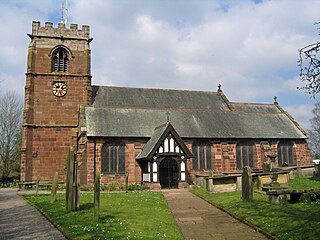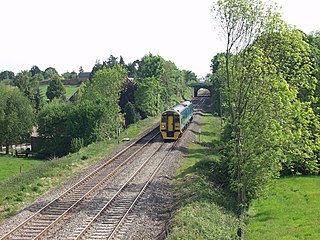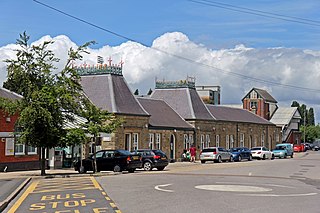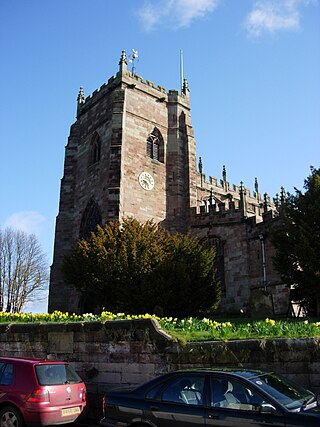
Tattenhall is a village and former civil parish, now in the parish of Tattenhall and District, 8 miles (13 km) south-east of Chester, in the unitary authority area of Cheshire West and Chester and the ceremonial county of Cheshire, England. In the 2001 census, the population was recorded as 1,986, increasing to 2,079 by the 2011 census.

The English county of Shropshire has a fairly large railway network, with 19 National Rail stations on various national lines; there are also a small number of heritage and freight lines, including the famous heritage Severn Valley Railway running along its eastern border with Worcestershire.

The Buckley Railway was opened from Buckley to a connection with the Chester to Holyhead main line on 7 June 1862, to convey coal and finished brickworks products from the Buckley area. Numerous short tramroads had existed in the area from the 1700s. The line was steeply graded and sharply curved.

The Wolverhampton–Shrewsbury line is the railway line from Wolverhampton to Shrewsbury via Wellington; it was originally built by the Shrewsbury and Birmingham Railway. The line is double track throughout, with rarely used relief sidings at Cosford and four tracks through Wellington station.

No Man's Heath is a village in the unitary authority of Cheshire West and Chester and the ceremonial county of Cheshire, England. Its name has historically also been spelt Nomansheath and Noman's Heath, the latter being the version formerly favoured by the General Post Office.

The Shrewsbury–Chester line is a railway line between Chester and Shrewsbury in England, with the line passing through Wrexham County Borough in Wales. Passenger train services are operated by Transport for Wales Rail between the northern terminal of Chester and Shrewsbury in the south as part of the Wales & Borders franchise. Some additional services, starting part way along the line to London Euston via Chester are operated by Avanti West Coast. The line was built in 1846 by the Shrewsbury and Chester Railway, with the engineer for the line being Henry Robertson, a partner in locomotive builders Beyer Peacock, while the contractor was Thomas Brassey in partnership with William Mackenzie and Robert Stephenson. The line is part of Transport for Wales' North Wales Metro improvement programme.

Pontypool and New Inn railway station is situated to the south east of Pontypool town centre between the town and the suburb of New Inn, Wales. The station was formerly called Pontypool Road until renamed just Pontypool in 1972 and then to the present name in 1994.

Wrexham General is the main railway station serving the city of Wrexham, north-east Wales, and one of the two serving the city, alongside Wrexham Central. It is currently operated and mostly served by Transport for Wales, with some additional services provided by Avanti West Coast to London Euston.

Malpas is a market town and a civil parish in the unitary authority of Cheshire West and Chester and the ceremonial county of Cheshire, England. It lies near the borders with Shropshire and Wales, and had a population of 1,673 at the 2011 census.
The Wrexham and Minera Railway or Wrexham and Minera Branch was a railway line in North Wales between the city of Wrexham, the village of Brymbo where it served the Brymbo Steelworks, and the lead mines and limeworks at Minera. A further branch ran from Brymbo to Coed Talon, where it connected with lines to Mold. The system was constructed in several stages between 1844 and 1872, while the various lines making up the system closed in 1952, 1972 and 1982.

Mouldsworth railway station opened on 22 June 1870 and serves the village of Mouldsworth in Cheshire, England. It is managed by Northern Trains. The station has two platforms and is on the Mid Cheshire Line, with hourly train services to Manchester Piccadilly and Chester.

Malpas railway station was a railway station that served the historic market town of Malpas, Cheshire on the Whitchurch and Tattenhall Railway or Chester-Whitchurch Branch Line. The station itself was located at Hampton Heath and was also known locally as Hampton Station.
Tattenhall railway station was a railway station in the village of Tattenhall, Cheshire on the Whitchurch and Tattenhall Railway or Chester-Whitchurch Branch Line, about a mile to the south of Tattenhall junction where the branch line diverged from the North Wales Coast Line running from Chester in the north-west towards Crewe to the south-east.

Tattenhall Road railway station was a railway station situated a mile to the north of the village of Tattenhall, Cheshire on the Chester and Crewe Railway that was built in 1840 linking Chester to the north-west with Crewe to the south-east. The track now forms part of the North Wales Coast Line.

The North Wales Mineral Railway was formed to carry coal and ironstone from the mineral-bearing area around Wrexham to the River Dee wharves. It was extended to run from Shrewsbury and formed part of a main line trunk route, under the title The Shrewsbury and Chester Railway. It opened in 1846 from Chester to Ruabon, and in 1848 from Ruabon to Shrewsbury. It later merged with the Great Western Railway.
The Crewe and Shrewsbury Railway was a railway company which was previously owned by the London and North Western Railway (LNWR), built to connect Crewe with the Shrewsbury and Hereford Railway which was jointly owned with GWR.
The Mold Railway was a railway company that built a line in north-east Wales. The line linked Mold to Chester and it opened on 14 August 1849. The company built a mineral branch line to Ffrith, opened in November 1849. Mold itself was an important regional centre, and contained considerable mineral resources.
The Oswestry, Ellesmere and Whitchurch Railway was a railway company that constructed a line from Whitchurch via Ellesmere to Oswestry. Most of the line was in Shropshire but part entered Flintshire, now Wrexham County Borough. It was seen as a link from the local railways around Newtown to the London and North Western Railway, breaking the local monopoly of the Great Western Railway. It opened as a single line in 1863 and 1864. Throughout the construction period it was short of money, and was paid for by the contractor, who took shares. Sporadically through its life it became a useful part of a through route for mineral trains, but it never developed greatly.
The Wrexham and Ellesmere Railway was a railway line that ran from Wrexham in North Wales, to Ellesmere in Shropshire, England. The line opened in 1895 and closed in 1962, except for a residual goods service which itself closed in 1981.
The Ruabon railway branch lines were a network of railways built to serve the mineral bearing area west of Ruabon, which contained many coal and iron deposits, as well as limestone, and a small but dense network of railways developed to handle the minerals.













